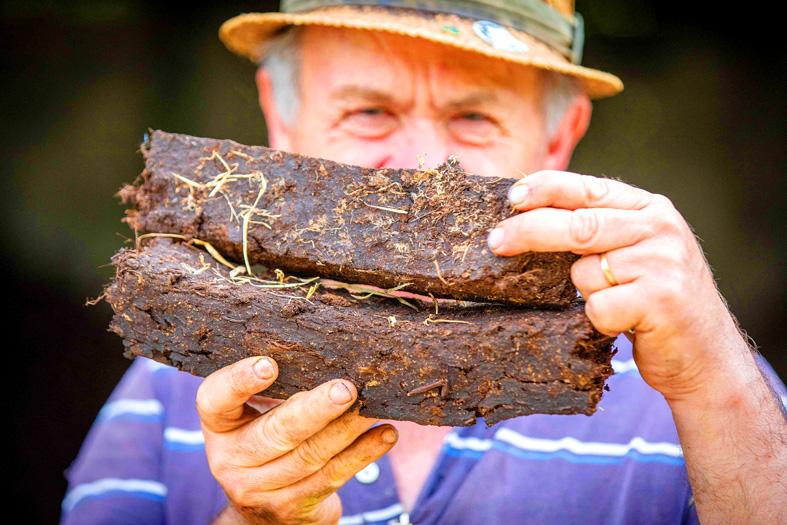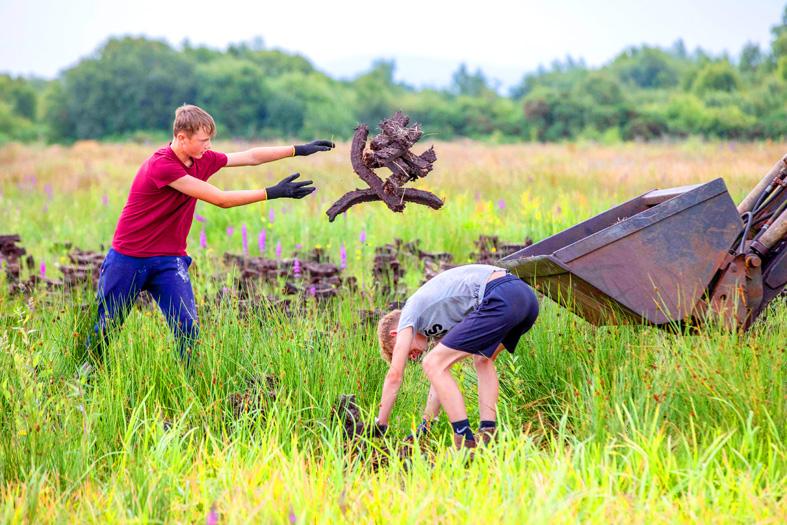In the aftermath of the hottest day in Ireland in more than 130 years last week, small family groups picked their way across the Bog of Allen in the country’s midlands collecting sun-dried turf.
The briquettes of peat, which are liquorice black when hewn wet from the ground, had turned a toasted brown in the soaring temperatures and were ready to be stored and burnt as winter fuel.
Yet the bog, like others across Ireland, has become a front line in a struggle to cut carbon emissions and conserve peat lands, pitting rural communities against urban policymakers.

Photo: AFP
“There’s very deep anger and resentment that the likes of the Green Party and urban members of the Green Party think ... they can run riot over the country people of Ireland,” Kildare Turf Cutters Association spokesman John Dore said.
The Irish Environmental Protection Agency (EPA) says that 14 percent of the Irish population use turf, a smoky fuel, to heat their homes.
For those who rely on the traditional energy source, which has been cut and burnt in the country for centuries, turf is a birthright.

Photo: AFP
“It’s a very cultural and community activity,” Dore said. “We’re fuel independent. It’s about being independent as well.”
During a visit to Japan on Tuesday, Irish Prime Minister Micheal Martin said his government needed to focus on emissions as it looks to set legally binding targets by the end of this month.
“I think what the heat waves are showing, it’s bringing it home to people the enormity of the consequences of climate change,” he told reporters in Tokyo. “It’s here now.”
EPA figures released on Thursday showed a 4.7 percent rise in greenhouse gas emissions last year compared with 2020 — up 1.1 percent from 2019 pre-COVID-19 levels.
Martin’s three-party governing coalition, which includes Ireland’s Greens, has been licking its wounds after it tried to place curbs on the sale of turf earlier this year.
A series of heated debates on the restrictions triggered a rebellion among the government’s rural deputies.
Irish lawmaker Mattie McGrath, an independent from Tipperary, said ministers needed a “trip back to the bog” to realize the effect proposed restrictions would have on low-income families living in rural areas.
As he unveiled revised plans to curb the retail sale of turf last week, Irish Minister for the Environment, Climate and Communications Eamon Ryan said controversial measures restricting the sale of turf to within communities of less than 500 people had been dropped.
Under the new rules, sales of turf to family, friends and neighbors would continue as before, but sales at retail outlets and online would be banned, along with the advertisement of turf sales in traditional media.
For Patsy Power, a turf cutter whose family has rights to cut and remove turf on the Bog of Allen, the changes would make virtually no difference to the way he operates.
“We’ve been taking turf from here all my life time,” said Power, 60, who has seven siblings who gather turf from the same plot.
“We wouldn’t be selling it anyway, it’s merely for domestic use and it’ll merely be family,” he said as he took a break from throwing clods into the back of his truck.
Dore called the government’s retreat a “bit of a victory.”
However, he said the compromise had also been driven by factors such as rising energy prices and fuel insecurity from the war in Ukraine rather than concern for rural communities.
The spokesman, who also cuts and stores turf at his home nearby, said he understood Ireland had international climate commitments, but characterized targeting turf farmers with curbs as “starting with the small guys.”
Conservationists have urged the government to grasp the nettle of turf cutting over the damage it does to bogs, which are natural carbon sinks and absorb carbon dioxide from the atmosphere.
“There’s no onus on turf cutters to restore the habitat or manage emissions from when they’re draining the bog,” Irish Peatland Conservation Council policy officer Tristram Whyte said.
“Along with that, all the peat silt enters the waterways and with the emissions there’s biodiversity loss,” Whyte said. “It’s the most emitting source of fuel that you can use ... the effects from burning peat is not worth the heat.”

Former Nicaraguan president Violeta Chamorro, who brought peace to Nicaragua after years of war and was the first woman elected president in the Americas, died on Saturday at the age of 95, her family said. Chamorro, who ruled the poor Central American country from 1990 to 1997, “died in peace, surrounded by the affection and love of her children,” said a statement issued by her four children. As president, Chamorro ended a civil war that had raged for much of the 1980s as US-backed rebels known as the “Contras” fought the leftist Sandinista government. That conflict made Nicaragua one of

BOMBARDMENT: Moscow sent more than 440 drones and 32 missiles, Volodymyr Zelenskiy said, in ‘one of the most terrifying strikes’ on the capital in recent months A nighttime Russian missile and drone bombardment of Ukraine killed at least 15 people and injured 116 while they slept in their homes, local officials said yesterday, with the main barrage centering on the capital, Kyiv. Kyiv City Military Administration head Tymur Tkachenko said 14 people were killed and 99 were injured as explosions echoed across the city for hours during the night. The bombardment demolished a nine-story residential building, destroying dozens of apartments. Emergency workers were at the scene to rescue people from under the rubble. Russia flung more than 440 drones and 32 missiles at Ukraine, Ukrainian President Volodymyr Zelenskiy

COMPETITION: The US and Russia make up about 90 percent of the world stockpile and are adding new versions, while China’s nuclear force is steadily rising, SIPRI said Most of the world’s nuclear-armed states continued to modernize their arsenals last year, setting the stage for a new nuclear arms race, the Stockholm International Peace Research Institute (SIPRI) said yesterday. Nuclear powers including the US and Russia — which account for about 90 percent of the world’s stockpile — had spent time last year “upgrading existing weapons and adding newer versions,” researchers said. Since the end of the Cold War, old warheads have generally been dismantled quicker than new ones have been deployed, resulting in a decrease in the overall number of warheads. However, SIPRI said that the trend was likely

‘SHORTSIGHTED’: Using aid as leverage is punitive, would not be regarded well among Pacific Island nations and would further open the door for China, an academic said New Zealand has suspended millions of dollars in budget funding to the Cook Islands, it said yesterday, as the relationship between the two constitutionally linked countries continues to deteriorate amid the island group’s deepening ties with China. A spokesperson for New Zealand Minister of Foreign Affairs Winston Peters said in a statement that New Zealand early this month decided to suspend payment of NZ$18.2 million (US$11 million) in core sector support funding for this year and next year as it “relies on a high trust bilateral relationship.” New Zealand and Australia have become increasingly cautious about China’s growing presence in the Pacific